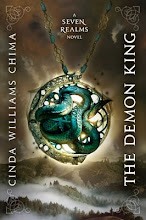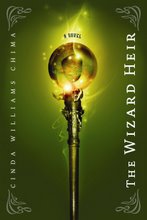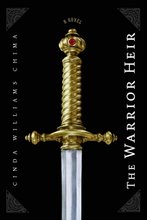Today I'm guest blogging over at The Story Siren. on the topic of World Building.
The term “worldbuilding” is often associated with fantasy fiction, because fantasy writers have so many options when it comes to setting.
Yet all novelists engage in worldbuilding, even for stories set in the so-called “real world.” My Heir Chronicles contemporary fantasy series is set in Ohio. Yes, there’s less ‘splainin’ to do about a contemporary Midwestern world, but I can’t assume that all of my readers have been here. And even if they have, it’s detail and specificity that will bring them back.
Also accuracy. If you get something wrong in a real-world setting, you will receive emails. Any reader who spots an error will be thrown completely out of the story and spend the rest of the book looking for the next mistake. Whether you write contemporary real-world fiction or epic fantasy, the reader must have confidence that you know what you’re doing.
Although I’ve been to most of the settings used in The Heir Chronicles, I still spent time researching so I could get it right. In one of the scenes in The Warrior Heir, the warrior Jack Swift and his Aunt Linda take refuge in St. Margaret’s Church, a real church next to Westminster Abbey in London. I’ve been to St. Margaret’s, but I couldn’t remember whether or not there were pews in there. I spent considerable time on the church website and travel sites, trying to find an interior view of the church.
World-building goes beyond landscape to social and cultural elements. Seph McCauley, one of the characters in The Wizard Heir, is Catholic. I don’t happen to be Catholic, so I did some fact-checking with my Catholic friends.
By now, you’re saying to yourself, “Maybe I’ll write high fantasy set in a made-up world. I won’t have to do any research and I won’t get any emails.”
Sorry, but no. Epic fantasy writers have to work much harder to put the reader in a world they’ve never been to and entice them to stay. It’s even more challenging because, like as not, the writer has never been there, either. The old adage, “Write what you know,” doesn’t work here.
Or does it? How do you go about creating a world that the reader believes in? You mingle the familiar and the fantastic.
Now coast on over to The Story Siren to read the rest!
Showing posts with label craft. Show all posts
Showing posts with label craft. Show all posts
Thursday, September 1, 2011
Sunday, March 22, 2009
What Hard Work Will Get You -- Or Not

I often hear from young writers, asking for advice. I try to answer their specific questions when I can. When asked for general advice, I have a kind of standard response that would have made my mother proud. You know. Success is all about hard work, study of craft, intensive reading of work in your genre, practice practice practice, with a seasoning of talent and luck. Don’t expect overnight success, I tell them. In order to be a writer, you have to love writing so much that you will write whether you get paid or not.
I began writing when I was a teenager, and though I didn’t write regularly in early adulthood, it took five years of constant writing (and four books) to get my work to where first an agent and then a publisher took interest in it.
I’m still learning, every single day. One thing I look for in a writing conference is a focus on craft, in addition to the usual sessions on how to find an agent or how to craft a query letter.
So it was with interest that I watched an interview with Stephenie Meyer that was included with the Twilight video. Although Meyer was an English major in college, she confessed that she just wanted a major that would allow her to read books for a grade. She took only one writing course in college and moved immediately into child-rearing after graduation.
You may have heard the story that the idea for Twilight came to Meyer in a dream. She wrote Twilight in three months, working around the demands of three small children. In a twinkling (my word) she had a three-book contract. And, of course, the Twilight series went on to be the kind of phenomenon that makes publishing history and bookseller bottom lines.
Hmmm. So much for long years of study and practice. Meyer was/is a voracious reader, but that seems to have been the sum total of her preparation for greatness.
Now, there are those who criticize the quality of the writing in the Twilight series. For instance, author Stephen King outraged Twilight fans when he described Meyer’s writing as “not very good.” Others have criticized the message she sends to young women.
But then, not everyone likes Stephen King, either. I’m not comparing myself to Meyer or King, but my books have come in for their share of criticism, too, along with some awards and good reviews. From a craft standpoint, Meyer certainly did better than I did on my first, unpublished try.
You’re never going to please everyone, but Meyer has been successful by every commercial measure. I think a lot of writers out there would gladly take the heat from critics if the first novel they wrote sold in the tens of millions.
What do you think? What’s the most important driver of publishing success for authors? Talent? Hard work? Luck? Connections?
Saturday, August 25, 2007
Wyoming Dreams or Where Do Writers Get Their Ideas?

I’m back from a long hiatus from the blogosphere, the consequence of a looming book deadline and vacation. We spent a week in Grand Teton and Yellowstone National Parks. I took my laptop along and did get some editing done during long car rides and other free moments. But Internet and phone access was chancy. Yellowstone especially was very low tech. My brand new I-phone toy wouldn’t even work in most parts of the park. Must be all that geothermal activity.
Actually, I was working the whole time. No, I didn’t take the laptop on the whitewater rafting trip. But writers are collectors of characters, images, and experiences that resurface in their work. And vacations by their definition provide access to substrate not found in the everyday.
Vacations are full of characters. The National Parks, like amusement parks and the county fair, have broad appeal that draws a cross-section of people. We often encounter the Foolhardy Family, who seem to believe that the natural world is a kind of Disneyland place where nothing bad can happen. We see them climbing over fences to get that great photo, posing Grandma and little Timmy with the bison, hanging over the hot spring, and dancing on the precipice.
There are the extreme sports people, who make a living guiding whitewater trips or soaring off mountain peaks in hang gliders with tourists strapped in tandem. In Alaska, our float trip guide confessed that the first priority of a seasonal guide is to find a girlfriend with a house, to avoid sleeping in a tent all summer. He passed along other guide strategies, like how to choose a 3-day shirt (the 3-day shirt comes in dark colors, so it doesn’t show the dirt.)
Vacations are often an intense sequence of experiences, to be stored up and savored over time. Grand Teton was a landscape of extremes: Mountains jagged enough to prick yourself on. Meadows sparkling with wildflowers, even in August, the scent of sagebrush after a rain (and we had plenty). Jackson Hole—where a converted house trailer on a speck of ground might cost $1.5 million, where fringed leather jackets and tooled Western boots and silver and turquoise jewelry were so in context I wanted to buy it all. A summer so short and sweet you want to dig in your heels and slow it down. I was continually ambushed by the beauty of the place. “Oh!” I kept saying. “Oh, my!”
Yellowstone was Tolkien-esque: fuming fissures, percolating mudholes and sulfur stinking springs surrounded by the grotesque skeletons of dead lodgepole pines. Mineralized water created chalky terraces and moonscape towers. Elk and bison picked their way across thin-crusted thermal meadows, oblivious to the posted signs-- “Dangerous Ground: Keep Off.” Hot springs dumped steaming water into the clear, cold Firehole River.
We stayed on the shores of lovely Yellowstone Lake with its underwater geysers and hot springs and volcanic beaches. We hiked Uncle Tom’s Trail into the Grand Canyon of the Yellowstone, descending metal stairs clinging to the side of a cliff to view a waterfall aas pretty as any I’ve seen.
We listened politely to the ranger lecture on magma chambers and calderas, but I knew for a fact that under our feet was a dragon imprisoned in an underground chamber, whose angry tail caused the ground to shake, and whose breath leaked out all over the park.
OK, so how does this relate to writing? Probably the most common question I get as a writer is “Where do you get your ideas?” And I often respond with a quote from Tolkien: “One writes such a story out of the leafmold of the mind.” This leafmold is a rich, fertile mixture of all the people you’ve met, the places you’ve been, the experiences you’ve had, and your emotional history. That’s where stories grow.
But we all have experiences, and many of us have ideas for books, but we’re not all writers. What sets the writer apart? Another possible metaphor comes from my family’s tradition of quiltmaking. The materials for pieced quilts came often from chance—scraps from sewing projects, remnants from old clothes, mill ends from the local textile mill. The substrate was necessary, but not sufficient. Give two quiltmakers the same materials, and they will create totally unique masterpieces. Writers are the same. They see the story in the fragments given to them, and they create something new and better from them.
So I think would-be writers focus too much on the quest for ideas. You don’t have to find a new idea, a unique idea, a great idea. It’s not all about the ideas. It’s about what you do with them. It’s about craft. And I’ll talk about that in other postings.
Actually, I was working the whole time. No, I didn’t take the laptop on the whitewater rafting trip. But writers are collectors of characters, images, and experiences that resurface in their work. And vacations by their definition provide access to substrate not found in the everyday.
Vacations are full of characters. The National Parks, like amusement parks and the county fair, have broad appeal that draws a cross-section of people. We often encounter the Foolhardy Family, who seem to believe that the natural world is a kind of Disneyland place where nothing bad can happen. We see them climbing over fences to get that great photo, posing Grandma and little Timmy with the bison, hanging over the hot spring, and dancing on the precipice.
There are the extreme sports people, who make a living guiding whitewater trips or soaring off mountain peaks in hang gliders with tourists strapped in tandem. In Alaska, our float trip guide confessed that the first priority of a seasonal guide is to find a girlfriend with a house, to avoid sleeping in a tent all summer. He passed along other guide strategies, like how to choose a 3-day shirt (the 3-day shirt comes in dark colors, so it doesn’t show the dirt.)
Vacations are often an intense sequence of experiences, to be stored up and savored over time. Grand Teton was a landscape of extremes: Mountains jagged enough to prick yourself on. Meadows sparkling with wildflowers, even in August, the scent of sagebrush after a rain (and we had plenty). Jackson Hole—where a converted house trailer on a speck of ground might cost $1.5 million, where fringed leather jackets and tooled Western boots and silver and turquoise jewelry were so in context I wanted to buy it all. A summer so short and sweet you want to dig in your heels and slow it down. I was continually ambushed by the beauty of the place. “Oh!” I kept saying. “Oh, my!”
Yellowstone was Tolkien-esque: fuming fissures, percolating mudholes and sulfur stinking springs surrounded by the grotesque skeletons of dead lodgepole pines. Mineralized water created chalky terraces and moonscape towers. Elk and bison picked their way across thin-crusted thermal meadows, oblivious to the posted signs-- “Dangerous Ground: Keep Off.” Hot springs dumped steaming water into the clear, cold Firehole River.
We stayed on the shores of lovely Yellowstone Lake with its underwater geysers and hot springs and volcanic beaches. We hiked Uncle Tom’s Trail into the Grand Canyon of the Yellowstone, descending metal stairs clinging to the side of a cliff to view a waterfall aas pretty as any I’ve seen.
We listened politely to the ranger lecture on magma chambers and calderas, but I knew for a fact that under our feet was a dragon imprisoned in an underground chamber, whose angry tail caused the ground to shake, and whose breath leaked out all over the park.
OK, so how does this relate to writing? Probably the most common question I get as a writer is “Where do you get your ideas?” And I often respond with a quote from Tolkien: “One writes such a story out of the leafmold of the mind.” This leafmold is a rich, fertile mixture of all the people you’ve met, the places you’ve been, the experiences you’ve had, and your emotional history. That’s where stories grow.
But we all have experiences, and many of us have ideas for books, but we’re not all writers. What sets the writer apart? Another possible metaphor comes from my family’s tradition of quiltmaking. The materials for pieced quilts came often from chance—scraps from sewing projects, remnants from old clothes, mill ends from the local textile mill. The substrate was necessary, but not sufficient. Give two quiltmakers the same materials, and they will create totally unique masterpieces. Writers are the same. They see the story in the fragments given to them, and they create something new and better from them.
So I think would-be writers focus too much on the quest for ideas. You don’t have to find a new idea, a unique idea, a great idea. It’s not all about the ideas. It’s about what you do with them. It’s about craft. And I’ll talk about that in other postings.
Subscribe to:
Posts (Atom)












